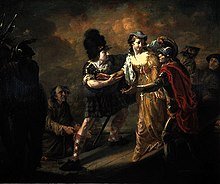1568: Mary, Queen of Scots, Escapes Lochleven Castle
On May 2nd, 1568, a significant event took place in Scottish history. Mary, Queen of Scots, managed to escape from Lochleven Castle, where she had been held captive by Scottish nobles. This daring escape was made possible with the help of her loyal supporters, and it marked a turning point in Mary’s tumultuous life.
The Imprisonment at Lochleven Castle
Prior to her escape, Mary, Queen of Scots, had endured a period of captivity at Lochleven Castle. The castle, situated on an island in Loch Leven, was the stronghold of the Douglas family, who were staunch opponents of Mary’s claim to the throne.
Mary’s imprisonment at Lochleven Castle was a result of the political turmoil and power struggles that plagued Scotland during the 16th century. After her forced abdication in 1567, Mary found herself at the mercy of her enemies, who saw her as a threat to their own ambitions.
During her time at Lochleven Castle, Mary faced numerous challenges. She was separated from her young son, James, who was declared the new king of Scotland. Mary’s movements were restricted, and she was closely monitored by her captors. However, her supporters remained loyal and were determined to help her regain her freedom.
The Daring Escape
With the assistance of her loyal supporters, Mary devised a plan to escape from Lochleven Castle. The details of the escape were carefully planned and executed to minimize the risk of discovery.
On the night of May 2nd, 1568, Mary managed to overpower her guards and make her way to the castle courtyard. She was then smuggled out of the castle and onto a waiting boat, which took her across the loch to freedom.
The escape from Lochleven Castle was a daring feat that required courage and resourcefulness. Mary’s supporters played a crucial role in ensuring her successful escape, risking their own lives to aid the queen.
The Aftermath
Following her escape from Lochleven Castle, Mary briefly reclaimed her power and rallied her supporters. However, her triumph was short-lived. The Scottish nobles who opposed her rule gathered their forces and engaged in a battle with Mary’s army at the Battle of Langside.
Despite her initial success in escaping from captivity, Mary was ultimately defeated at the Battle of Langside. This defeat marked a significant setback for Mary and her supporters, and it led to her subsequent exile.
Mary, Queen of Scots, would go on to face further hardships and challenges in her life. She sought refuge in England, hoping for the support of her cousin, Queen Elizabeth I. However, her presence posed a threat to Elizabeth’s own reign, and Mary was eventually imprisoned and executed on charges of treason.
Conclusion
The escape of Mary, Queen of Scots, from Lochleven Castle in 1568 was a pivotal moment in Scottish history. It demonstrated the determination and resilience of Mary and her loyal supporters in their quest for power and freedom. Although her escape was short-lived, it left a lasting impact on the narrative of Mary’s life and the turbulent political landscape of 16th-century Scotland.
For more information on this event and the life of Mary, Queen of Scots, you can refer to the following external references:
- Britannica: Mary, Queen of Scots
- Historic Environment Scotland: Lochleven Castle
- BBC History: Mary, Queen of Scots
These sources provide further insights into the historical context, evidence, and significance of Mary’s escape from Lochleven Castle.

